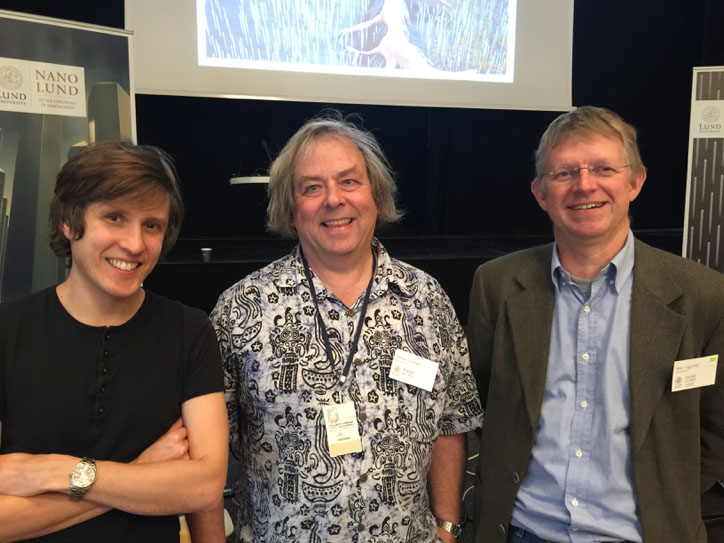


Lund University (ULUND) (www.lu.se) seeks to be a world-class university that works to understand, explain and improve our world and the human condition. The University is ranked as one of the top 100 in the world. With 47 700 students and 7 500 employees at campuses in Lund, Malmö and Helsingborg, the University has a turnover of around €844M, of which two thirds go to research. Lund is an international university with 680 partner universities in over 50 countries and the only Swedish university to be a member of LERU and Universitas 21. Lund University operates the MaxLab synchrotron facility (www.maxiv.lu.se) where the next generation facilities at MaxIV will open mid-June 2016.
Research at the division of Physical Chemistry (www.physchem.lu.se) deals with surface and colloid science with strong links between experiment and theory, from basic considerations of intermolecular interaction to practical consequences in industry and medicine. A key area is formulation science involving lipids, surfactants and polymers. Physical Chemistry is actively involved in NanoLund.
The Division of Solid State Physics (www.ftf.lth.se) at Lund University engages in research and education in nanoscience, specifically in materials science, in the physics of low-dimensional semiconductors, and in their interdisciplinary applications. Currently, a strong research focus is placed on the materials science and the controlled design and growth of semiconductor nanowires as well as the use of novel, functional devices based on nanowires in a wide range of applications, including quantum electron transport, nanoelectronics, energy conversion, optoelectronics, photonics, nanotoxicology, and nano biophysics. NanoLund is managed from Solid State Physics.
NanoLund (www.nanolund.lu.se) supports and coordinates activities within nanoscience and nanotechnology at Lund University. The overarching goal is to use nanostructures to address important needs of society, such as solving the energy challenge and improving the quality of life. The scientific focus are the materials science, the safety and the fundamental physics and chemistry of highly controlled, functional nanostructures, as well as their applications in fundamental science, in energy conversion, in electronics and in the life sciences. Currently, a strong research focus is placed on the materials science and the controlled design and growth of semiconductor nanowires as well as the use of novel, functional devices based on nanowires in a wide range of applications, including quantum electron transport, nanoelectronics, energy conversion, optoelectronics, photonics, nanotoxicology, and nano biophysics.This includes the continuous development of advanced tools for the fabrication, characterization and theory of nanostructures, with a current focus on semiconductor nanowires.
Prof. Tommy Nylander. Physical Chemistry of Biointerfaces. The main theme of the scientific activity has been to relate interfacial behaviour of surface-active molecule to their solution behaviour. The focus has been on molecules of biological origin, e.g. proteins and lipids, and the self-assembled structures they form in bulk and at interfaces. The relation between solution and interfacial behaviour is crucial in many systems, in particular for lipids and proteins, but also on polymer-surfactant system. Focus is on interfacial techniques such as ellipsometry, surface film balance, QCM-D and neutron reflectometry. Nylander has a large experience on application research and on international collaboration both with academia and industry.
Prof. Jonas Tegenfeldt. Solid State Physics. Label-free particle sorting – Tegenfeldt's group pioneered a unique microfluidic cell-sorting scheme that fractionates cells based on not only size but also shape and deformability. This is useful for defining subpopulations of cells based on their inherent mechanical properties, a characteristic that is finding increased interest
in cell biology. DNA analysis in nanochannels – Tegenfeldt invented the usage of nanochannels to stretch DNA and further developed the concept in his group by introducing a simple labeling scheme that results in a barcode pattern that can be used to identify large-scale genomic structures in long DNA molecules.
Ass. Prof. Joachim Stenhammar, Physical Chemistry. The group’s research focuses on various aspects of soft matter modelling, in particular of colloidal suspensions far from thermodynamic equilibrium. The present projects involves: Thermodynamics of active Brownian particles, Collective behaviour of swimming microorganisms, Directed self-assembly of anisotropic colloids as well as Computational modelling of responsive microgels.
Joakim Stenhammar will be responsible of theoretical modeling and numerical simulations of interactions between EVs and nanostructured surfaces.


evFOUNDRY has received funding from the European Union’s Horizon 2020 research and innovation programme under grant agreement No 801367